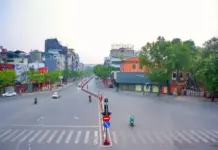 |
| A woman receives food for her child from UNICEF – PHOTO: COURTESY OF UNICEF |
As much as 10 tons of ready-to-use therapeutic food has been distributed to commune health centers through coordination between the UNICEF, the National Institute of Nutrition and other partners. More nutrition supplies are arriving to treat over 4,000 acutely malnourished children for the next three months.
“There’s no time to lose to get therapeutic food to the frontline healthcare workers in communes to treat children suffering from malnutrition,” said Rana Flowers, UNICEF representative to Vietnam.
“These acutely malnourished children cannot wait. With the downturn caused by Covid-19, many families in this region were already struggling to provide three nutritious meals a day, and the flooding has dramatically compounded their situation,” she added.
To help address the devastating flood emergency in central Vietnam, UNICEF is providing life-saving relief to vulnerable children and women from the affected areas. The fund has ordered a total of 60 tons of food to be shipped to Vietnam in the coming weeks from its Supply Division in Copenhagen.
The food meets international standards and is in the form of a soft biscuit that provides all the energy and micro-nutrients required for the treatment of severe acute malnutrition. The most severely malnourished children will be prioritized, ensuring that they get immediate benefits.
According to Rana Flowers, children have been among the most affected by the recent natural disasters and the pandemic. “UNICEF is working with partners to bring emergency relief to the affected children and women in central Vietnam, prioritizing access to clean water, sanitation facilities, healthcare, nutrition, education, psycho-social support and child protection,” she said.
Up to now, UNICEF has mobilized US$2.6 million from the governments of Australia and New Zealand, the United Nations’ Central Emergency Response Fund and other supporters in multiple countries to address the urgent needs of the most vulnerable children, their families and communities in the most affected provinces.



